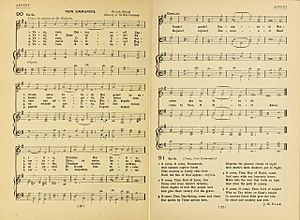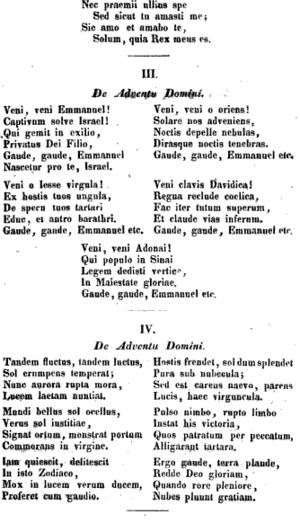O Come, O Come, Emmanuel facts for kids
Quick facts for kids O Come, O Come, Emmanuel |
|
|---|---|
 |
|
| Native name | Veni, veni, Emmanuel |
| Genre | Hymn |
| Written | 1861 (translated) |
| Text | John Mason Neale, translator |
| Based on | Matthew 1:23 |
| Meter | 8.8.8.8. (L.M.) with Refrain |
| Melody | "Bone Jesu dulcis cunctis" (anon., 15th c.) |
"O Come, O Come, Emmanuel" is a very old and famous Christian hymn. It is often sung during Advent (the time before Christmas) and at Christmas. The original words were written in Latin.
This hymn is based on special prayers called the "O Antiphons". These prayers were sung in monasteries over 1,200 years ago, starting about seven days before Christmas Eve. They were a way to get ready for Christmas. The Latin words for the hymn were put into a song form as early as the 12th century.
The most popular English version was translated by John Mason Neale in 1861. Many other languages also have their own versions. The hymn is usually sung with its most famous tune, which is also called Veni Emmanuel. This tune was first used with the English words in 1851.
Contents
The Latin Words: How the Hymn Began
The words and the music of "O Come, O Come, Emmanuel" grew separately. The Latin words first appeared in a book in Germany in 1710. The tune we know best comes from 15th-century France.
The First Latin Version
Even though some say the Latin hymn is much older, it first appeared in a hymnal called Psalteriolum Cantionum Catholicarum in 1710. This hymnal was very important for German church music. It was first put together by a Jesuit priest named Johannes Heringsdorf in 1610. Many updated versions were made over the years.
Each part of the hymn is a short poem based on one of the "O Antiphons." It also has a two-line chorus that says: "Rejoice, Rejoice! Emmanuel will be born for you, O Israel." The first version had five parts. The order of the parts was different from the original "O Antiphons." The last antiphon, "O Emmanuel," became the first part of the hymn. This is how the hymn got its name, "Veni, veni, Emmanuel."
1. Come, come, Emmanuel!
Free captive Israel!
Who mourns in exile,
Without God's Son.
Rejoice, rejoice, Emmanuel
will be born for you, Israel.
2. Come, O Branch of Jesse!
From the enemy's claw,
From the pit of hell,
Lead your people out.
3. Come, come, O Dayspring!
Comfort us as you arrive,
Drive away the night's mists,
And the terrible darkness of night.
4. Come, Key of David!
Open the heavenly kingdoms,
Make safe the path above,
And close the ways to hell.
5. Come, come, Adonai!
Who on Mount Sinai
Gave the law to your people,
In glorious majesty.
In 1844, a German hymn expert named Hermann Adalbert Daniel included the 1710 text in his large collection, Thesaurus Hymnologicus. This helped keep the Latin words alive. John Mason Neale later found the hymn in this collection. He then published the Latin version in Britain and made the first important English translations.
Adding More Latin Verses
In 1878, two more verses were added to the 1710 text in a book called Cantiones Sacrae. These new verses were based on the two "O Antiphons" that were missing from the first version. The order of the verses was also changed to match the original antiphons. The hymn's title in this book became "Veni, O Sapientia" (Come, O Wisdom). The chorus was also changed slightly to "Rejoice, rejoice, O Israel. Soon shall come Emmanuel."
English Versions of the Hymn
John Mason Neale published the five-verse Latin version in his 1851 book Hymni Ecclesiae. He likely learned it from Daniel's collection.
In the same year, Neale also published the first English translation. It started with "Draw nigh, draw nigh, Emmanuel." He updated this version several times. In 1861, he made another change for Hymns Ancient and Modern. This version, which began with "O come, O come, Emmanuel," became the most popular in English-speaking countries.
Later, in the 20th century, the two extra Latin verses were translated into English. A translation by Henry Sloane Coffin in 1916 became widely accepted. A full seven-verse English version first appeared in 1940 in the Hymnal of the Episcopal Church.
Today, English hymnals have different versions, from four to eight verses. Many of these versions combine lines from Neale's original translations and later updates.
The Music: The Famous Tune
"O Come, O Come Emmanuel" is a metrical hymn. This means its words fit a specific rhythm pattern (88.88.88). So, you could sing the words with many different tunes. However, in English-speaking countries, it is almost always sung with one special tune. This tune is so famous that it is often called Veni Emmanuel itself.
The "Veni Emmanuel" Tune's Story
The well-known "Veni Emmanuel" tune was first used with this hymn in 1851. Thomas Helmore published it in a book called Hymnal Noted. He said the tune came from a French book in a library in Lisbon. But he didn't give enough details, so people wondered if he had made up the tune himself.
The mystery was solved in 1966 by a British music expert named Mary Berry. She found a 15th-century handwritten book in the National Library of France in Paris. This book contained the melody. It was used for songs sung during funerals. The tune Helmore used was found with the words "Bone Jesu dulcis cunctis."
Mary Berry noted that this might not be the exact book Helmore used. But her discovery showed that the tune was indeed very old. There is no proof that this tune was used with the "O Come, O Come, Emmanuel" words before Helmore's hymnal. So, the words and music likely came together for the first time in English. However, because of how metrical hymns work, the tune can easily be used with the Latin words too.
Why This Tune Became So Popular
The combination of the hymn's words and the Veni Emmanuel tune became very important. People loved the hymn's beautiful poetry and its old, medieval feel. Also, there was a growing interest in using hymns that fit the different seasons of the church year.
The Hymnal Noted, where the words and tune first met, was a key part of this trend. It only had Latin hymns and plainchant music, like the Veni Emmanuel tune. This new style of hymn singing became very popular.
"O Come, O Come Emmanuel" was perfectly placed to become a hit when Hymns Ancient and Modern was published in 1861. This new hymnal aimed to be popular with everyone. It included high-quality hymns of all kinds.
The book was a huge success. By 1895, three out of four churches in England were using Hymns Ancient and Modern. It helped spread new ideas about church music and worship far beyond England. This is why the version of "O Come, O Come, Emmanuel" found in Hymns Ancient and Modern is still the most common today.
Other Tunes for the Hymn
While the "Veni Emmanuel" tune is the most popular in English, other tunes have been used with the hymn.
In the United States, some Lutheran churches use a tune called "St. Petersburg." A Moravian hymnal uses a tune by Charles Gounod.
Different tunes are especially common in Germany, where the hymn's words first appeared. This is because the hymn was used there for many years before the "Veni Emmanuel" tune became widely known.
One German version of the hymn, by Christoph Bernhard Verspoell, has its own special tune. This tune has been popular for a very long time in the Diocese of Münster.
Another German translation by Heinrich Bone is often sung with a tune from an 1836 collection. This tune is still popular in German songbooks today. It was also brought to the United States by Johann Baptist Singenberger and is still used by some Catholic groups there.
Musical Influence: Where You Might Hear It
The melody of "O Come, O Come, Emmanuel" has inspired many famous composers and artists. Here are some examples:
- Ottorino Respighi used the tune in his music piece Trittico Botticelliano (1927).
- Zoltán Kodály wrote a choral song called "Adventi ének (Advent song: Veni, veni Emmanuel)" in 1943, based on the melody.
- Samuel Barber included the tune in his work Die natali, Op. 37 (1960).
- George Dyson used the theme in the first part of his Concerto da Chiesa (1949).
- American composer John Davison quoted the melody in his Sonata for Trombone and Piano (1957).
- The composer James MacMillan wrote a percussion concerto called Veni, Veni, Emmanuel in 1991.
- Sufjan Stevens included it on his 2006 album Songs for Christmas.
- U2's song "White as Snow" (2009) uses the hymn's tune.
- The Scottish band Belle and Sebastian recorded a version for the 2000 charity album It's a Cool Cool Christmas.
- Halford included a short version on their 2019 album Halford III: Winter Songs.
- World fusion artist Scott Jeffers Traveler recorded a version on his Old World Christmas album in 2011.
- Punch Brothers released a cover version on the 2012 album Holidays Rule.
- Kelly Clarkson included the song on her Christmas album Wrapped in Red (2013).
- Punk rock band Bad Religion recorded an upbeat version for their 2013 album Christmas Songs.
- Finnish soprano Tarja Turunen included the song on her classical album From Spirits and Ghosts (Score for a Dark Christmas) (2017).
Images for kids
See also
 In Spanish: Veni, veni, Emmanuel para niños
In Spanish: Veni, veni, Emmanuel para niños





